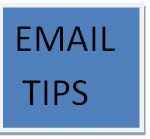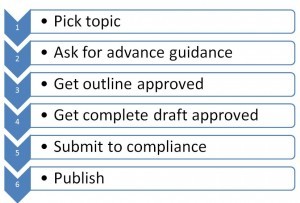Susan B. Weiner's Blog, page 58
October 6, 2015
Writing tip: Make your sentences more powerful!
Make your sentences more powerful with the writing tip you’ll learn in this short video. It’ll take you less than two minutes to learn a valuable lesson.
This is a tip that I share in my presentations on “How to Write Investment Commentary People Will Read” and “Writing Effective Emails.” Contact me to learn how one of my presentations can help your company or professional society.
http://www.investmentwriting.com/newsite/wp-content/uploads/2012/09/Rewrite-Sentence-video.m4v
If you enjoyed this video, you’ll also like “Can YOU simplify investment commentary better than this?“
The post Writing tip: Make your sentences more powerful! appeared first on Susan Weiner's Blog on Investment Writing.
September 29, 2015
Improve your email subject-line vocabulary with “The Hamster Revolution”
Boosting the power of your email subject lines is the best way for most people to boost the effectiveness of their emails. It’s a focus of my email presentations.
In this post, I share subject-line tips from The Hamster Revolution: Stop Info-Glut—Reclaim Your Life! by Mike Song, Vicki Halsey, and Tim Burress. Some of their suggestions may be most useful to team members who email each other frequently.
Start email subject lines with these keywords
The Hamster Revolution suggests starting your email subject lines with words that define their category. “These categories build context and rapid comprehension for your reader,” say the authors.
Here are the category words recommended by the authors:
Action
Confirmed
Delivery
Info
Request
Action and Request
The authors don’t say when to use “Action” instead of “Request.” I see the two as overlapping. Either word could start a subject line saying “help George to prepare plan.” In my opinion, you can drop “Action” in favor of “Request.”
Confirmed
“Confirmed” can precede the details of an appointment or agreement. For example, “Confirmed: Oct. 15, 3 p.m. meeting.”
Delivery
The meaning of “delivery” in an email subject line isn’t immediately clear. For this reason, it’s most appropriate for use with members of your team after you train them in its meaning.
Here’s how Hamster Revolution defines it:
Delivery is used when you’re responding to a specific request. It’s your way of saying “I’m delivering exactly what you requested.”
Info
To me, “Info” signals that an email simply provides information; it doesn’t require a reply. If I’m waiting for that information, I quickly realize that the sender has satisfied my needs. On the other hand, I may be able to file the email without reading it. That’s a time-saver.
I’m more likely to use FYI than “Info,” but either is fine.
Handy abbreviations
Abbreviations can help teams to communicate more efficiently. When I led an investment communications tea m at an investment management firm, we used “EOM.” As I discussed in “Fit it in your subject line EOM,” EOM appears at the end of the subject line and is short for “end of message.” It means that there’s no need to open the email because the entire message appears in the subject line.
The Hamster Revolution suggests two more subject line abbreviations:
NRN for “no reply needed”
NTN for “no thanks needed”
I can imagine both abbreviations saving time for teams. However, NTN could seem a bit obnoxious, as if you’re saying “You really ought to thank me, but I’ll let you get away without doing it.”
Best for team emails
These subject line tips will be most powerful when used with your team members, especially after you’ve trained them on their use.
When communicating with clients, you may prefer to skip category words in favor of other powerful words. For example, if clients are waiting for information on the XYZ Fund, the subject line “XYZ Fund info” more efficiently conveys your message than “Info: XYZ Fund.” This is because readers focus more on the first words of your email subject lines.
Stay away from abbreviations such as EOM and NRN with clients, unless you know they understand them. You’ll confuse them.
Disclosure: If you click on the Amazon link in this post and then buy something, I will receive a small commission. I only link to books in which I find some value for my blog’s readers.
The post Improve your email subject-line vocabulary with “The Hamster Revolution” appeared first on Susan Weiner's Blog on Investment Writing.
September 22, 2015
Use a wacky days list when you run out of blog ideas
If you ever run low on blog post ideas, a wacky days list may solve your problem. You can use the list as the basis for brainstorming exercises. Whether it’s  Employee Appreciation Day or Be Nasty Day, it’s amazing how a holiday calendar can spark ideas for your financial blog.
Employee Appreciation Day or Be Nasty Day, it’s amazing how a holiday calendar can spark ideas for your financial blog.
Days with obvious relevance
The titles of some days may lead directly to blog post ideas. For example, Employee Appreciation Day made me think of:
How you can help your employees by offering a better 401(k) plan
How your firm appreciates its employees’ continued learning as they try to better serve clients
Three budget-friendly ways to show your appreciation for your employees
Days that trigger personal stories
Some of the calendar days may trigger personal memories that you can use to make a point for your readers. Let’s take National Frozen Food Day. You have a blog post if you remember the great “deal” on frozen food that went bad when you didn’t have enough room in your freezer. There’s a lesson about false economies.
Days that serve as metaphors
Plant a Flower Day could serve as a metaphor. You can suggest steps that your clients can take that will brighten their financial lives as a flower might brighten their gardens.
How about YOU?
How do you use holidays or named days to inspire your blog’s editorial calendar? I’d like to hear from you.
Image courtesy of MR LIGHTMAN at FreeDigitalPhotos.net
The post Use a wacky days list when you run out of blog ideas appeared first on Susan Weiner's Blog on Investment Writing.
September 15, 2015
8 ways blogging is like bicycling
Bicycling is my favorite summer exercise. The more I bike, the more I’m struck by the similarities between bicycling and blogging.
1. It gets easier with practice
Falling off and skinning my knees when I learned to ride a two-wheeler was no fun. But after awhile, I stopped falling and I covered every mile with greater ease.
In a similar way, blogging gets easier as you practice more. Like figuring out where to place your weight to stay upright on your bike, you develop a sense of the proper balance among your blog’s components. As you pedal with less effort, you also write with less effort.
2. It’s easier to follow trails
I’m a fan of bicycle trails like the Minuteman or Nashua River Rail Trails. Following a path that’s paved and marked with signs is less stressful than navigating the Boston area’s road maze, having to make decisions at every corner.
As a blogger, you’ll find it easier to follow well-marked writing paths. For example, a list post follows a simple structure:
Introduction of your theme
A numbered list of points addressing your theme
Conclusion or call to action
I’ve described more models in the following posts:
Make your writing easier with my fill-in-the-blanks approach for structuring articles
Finding easy-to-follow formulas for your blog posts
3. Shorter is easier
It’s easier for me to cover five miles than 50 miles on my bike. Still a five-mile ride is so short that it’s unsatisfying. I like to cover at least fifteen miles on a ride.
Shorter is easier for bloggers, too. That’s why I recommend a length of 250 to 400 words for beginning bloggers. I typically run about 400 to 600 words. But just as I occasionally stretch myself in a long bike ride, I sometimes write longer. Most people will struggle to say something significant in less than 250 words unless they’re using a nontraditional form, such as a podcast, video, or infographic.
4. Visual appeal matters
Some of my favorite bike trails follow rivers, offering plants, wildlife, and water to delight my eyes.
Visuals—photos and other images are important to blog posts, too. They help attract the attention of readers. They also illustrate your points, aiding your readers’ understanding.
Sometimes the visuals of a bike ride and a blog post overlap. I’ve written some blog posts, such as “Focus your blog post or lose your readers,” inspired by bike rides and illustrated by photos taken on those rides.
5. A buddy helps
I almost always bicycle with my husband. We enjoy exploring new areas together. He pushes me to bike farther than I would go on my own. He’s also my mechanic, fixing problems I can’t tackle alone.
A blogger can benefit from two kinds of buddies, in my opinion.
First, a buddy can encourage you, as I described in “How a blogging buddy can help your financial planning or investment blog” and “Blogging buddies: Financial bloggers’ secret weapons.”
Second, a virtual assistant or more technically skilled helper can manage challenges you can’t—or don’t want—to handle, as I described in “9 Ways a Virtual Assistant Can Streamline Your Financial Advisor Blogging” on Michael Kitces’ blog.
6. Sometimes you wipe out
I still remember wiping out my bicycle in the Provincetown dunes on Cape Cod. It was my first time using hand brakes. I was used to a one-speed bike on which I stopped myself by pedaling backwards. That didn’t help me as I gathered speed riding downhill. I gained my last—I hope—skinned knee of my adult years.
As a blogger, you’ll make mistakes. They’ll be less physically painful, but they’ll still sting. For example, one time I scheduled two blog posts on the same day. Other times, I’ve written posts for which I had high hopes, but they failed to attract the attention I desired. However, just as I learned to use my bike’s hand brakes, I’ve become more skillful at blogging. You will, too.
7. Good equipment and precautions help
My bicycling became more enjoyable when I upgraded from a bike with lever gears and dropped handlebars that forced me to hunch over. Now I only ride bikes with dial gears and straight handlebars. It’s so much more comfortable.
My helmet isn’t as comfortable. However, I wear it on every ride for protection.
For your blogging comfort, find a platform, such as WordPress, that’s suited to your level of technical expertise. You may also find my book, Financial Blogging: How to Write Powerful Posts That Attract Clients helpful.
For protection, make sure that you follow best practices for website security. If you allow comments on your blog, consider getting help from an anti-spam plugin. I’ve had a good experience with the Anti-spam plug-in, which has replaced Akismet for me.
8. It helps to share the load
A well-prepared cyclist carries a heavy load. It might include a pump, spare tube, a lock, tools, and extra water. It adds up.
I’m lucky that my husband carries the extras in his backpack. My load is light—just whatever I carry in the bag strapped around my waist.
In blogging, it also helps to share the load with others. That might mean recruiting other people to post on your blog. You might use guest bloggers. Or, you can recruit other members of your firm to participate in a group blog.
Sharing the load with other bloggers eases your burden, assuming that they’re reliable. Just as I’d be disappointed if my husband left his tire repair kit at home, you won’t like it if your fellow contributors let you down. I’ve written about how to keep a group blog going in “How to manage a group blog: Financial advisor edition.” When it works well, it’s wonderful.
For me, the joy of bicycling comes from savoring each experience. I hope you find the same satisfaction with blogging.
______________________________________________________________________
Learn to write better! Buy Financial Blogging: How to Write Powerful Posts That Attract Clients.
Copyright 2015 by Susan B. Weiner All rights reserved
This content may not be reposted without the author’s written permission.
The post 8 ways blogging is like bicycling appeared first on Susan Weiner's Blog on Investment Writing.
September 8, 2015
“Within” vs. “in”
 You can usually replace “within” with “in” to streamline your writing. “The change almost always improves a sentence,” as Bruce Ross-Larson says in Edit Yourself: A manual for everyone who works with words.
You can usually replace “within” with “in” to streamline your writing. “The change almost always improves a sentence,” as Bruce Ross-Larson says in Edit Yourself: A manual for everyone who works with words.
However, there are exceptions. For example, as Michael Strumpf and Auriel Douglas say in The Grammar Bible:
An even that will take place in an hour will occur will occur at the end of sixty minutes. An event that will take place within an hour may occur any time between the present and sixty minutes from the present.
Ross-Larson describes when you must favor “within”:
Within should be used when the object of the preposition is an area or space—and as a synonym for inside of, as in limits.
Did you understand this distinction? I confess that I had to do research to learn about it.
Disclosure: If you click on the Amazon link in this post and then buy something, I will receive a small commission. I only link to books in which I find some value for my blog’s readers.
______________________________________________________________________
Learn to write better! Buy Financial Blogging: How to Write Powerful Posts That Attract Clients.
Copyright 2015 by Susan B. Weiner All rights reserved
This content may not be reposted without the author’s written permission.
The post “Within” vs. “in” appeared first on Susan Weiner's Blog on Investment Writing.
September 1, 2015
Credit sources fairly in your financial blog posts
You want to do the right thing when you find an interesting idea, statistic, or quote that you use on your blog. That means crediting your source. How much information must you provide?
Citation rules for blogs aren’t as clear as for books, where sources such as The Chicago Manual of Style lay out rules. I’ve developed suggestions for you based on my experience, Ann Handley’s Everybody Writes: Your Guide to Creating Ridiculously Good Content, and other resources.
1. Figure out if you’re entitled to quote the material.
Copyright and the concept of “fair use” govern your rights. The guidelines are murky. One key idea is that if you use the “heart” of the work, you’re in trouble, as explained in the “Amount and Substantiality of the Portion Used” on the University of Minnesota’s “Copyright Information and Resources” page.
You’ll find more “fair use” tips and resources in “Legal danger for financial bloggers: Two misconceptions, three resources, one suggestion.” Some sources may have their own guidelines, as discussed in “Are you crediting your OECD data properly?”
In another example, Hubspot asks that you limit quotes on your website to “no more than 75 words. This is to prevent duplicate content issues that would impact both our own organic search rankings and the other website’s,” according to Corey Eridon’s “How to Cite Sources & Not Steal People’s Content on the Internet.”
2. Name and link to your source
At a minimum, you should name the publication or resource that’s the source of your information, whether it’s a blog, newspaper, conference presentation, or something else. Some people minimize the information, saying something like “according to The New York Times.”
I like to go further than that, naming the article and, possibly, the author.
3. Link to the source.
It’s courtesy to link to the source you’re crediting, assuming it’s available online. If your compliance professionals are uneasy about links, then make sure you follow the advice in my next tip.
4. Provide enough information for your readers to find the source on their own
I’ve struggled with how much information to put in a citation. Then I read the suggestion in Everybody Writes that you should provide “enough information about the author and the work that someone could easily find it if the original link breaks.” Ann Handley made this suggestion in Everybody Writes’ chapter on content curation, “Curate Ethically.” I think it should apply to citations in blog posts in addition to content curation.
Handley also warns readers against linking to other people’s content using nofollow links—links that deprive the author of the linked material of a boost to their search ranking. I agree. It isn’t fair.
Providing enough information might mean giving a link to “Susan Weiner’s post, ‘How a blogging buddy can help your financial planning or investment blog’” instead of “Susan Weiner’s blog.”
Strike the right balance in giving credit to your sources!
A smart, fair strategy will boost your credibility.
Disclosure: If you click on the Amazon link in this post and then buy something, I will receive a small commission. I only link to books in which I find some value for my blog’s readers.
Image courtesy of Stuart Miles at FreeDigitalPhotos.net
______________________________________________________________________
Learn to write better! Buy Financial Blogging: How to Write Powerful Posts That Attract Clients.
Copyright 2015 by Susan B. Weiner All rights reserved
This content may not be reposted without the author’s written permission.
The post Credit sources fairly in your financial blog posts appeared first on Susan Weiner's Blog on Investment Writing.
August 25, 2015
Don’t break up your text too much!
I’m a big fan of breaking up text with headings and paragraph breaks. But sometimes you can go too far with this, as Roy Peter Clark reminded me in How To Write Short: Word Craft For Fast Times .
.
If you have an opportunity to make all of your text viewable on one page, consider taking it.
The potential benefit? One of the biggest is that you can quickly decide “whether the topic is worth your time,” says Clark.
Of course, a strong introductory paragraph also makes that possible. What it can’t do is show you the piece’s “beginning, middle, and end all at the same time, helping you sense the logic of the whole,” as Clark says.
Of course, single-glance texts only work in a limited number of cases. As examples, Clark mentions coupons, soup labels, and “advertisements on the outfield wall.” In financial services, a simple webpage might be a single-glance text. Something that requires compliance disclosures isn’t likely to work.
Can you think of cases where you could use single-glance text?
Disclosure: If you click on the Amazon link in this post and then buy something, I will receive a small commission. I only link to books in which I find some value for my blog’s readers.
Image courtesy of patpitchaya at FreeDigitalPhotos.net
______________________________________________________________________
Learn to write better! Buy Financial Blogging: How to Write Powerful Posts That Attract Clients.
Copyright 2015 by Susan B. Weiner All rights reserved
This content may not be reposted without the author’s written permission.
The post Don’t break up your text too much! appeared first on Susan Weiner's Blog on Investment Writing.
August 18, 2015
7 ways to manage writing by committee
The best way to manage writing by committee? Avoid it. As Ann Handley says in Everybody Writes: Your Go-To Guide to Creating Ridiculously Good Content,
Having a buddy by your side is helpful. Having an entire committee on your back? Not so much.
However, writing in a regulated industry means that many of you must get your materials reviewed by compliance. Also, if you’re a financial marketer, your  subject-matter expert will want to check your work.
subject-matter expert will want to check your work.
I have some tips, based on my experience as director of investment communications for an asset management firm.
Tip 1. Develop a process
Haphazardly approaching the review and approval of your project can slow you down as you must think about what’s the next step. Avoid this headache by developing a process. Identify who needs to be involved and when. Also, how long they need for their roles in the process.
For example, reviewing a fund commentary might involve your sending it to a subject-matter expert, then a proofreader, and, finally, your compliance professional, who may bounce it back to you.
If you work as part of a team, put your process into a flow chart to share with team members. Include the names or functions of the people involved, along with how long they’re allowed to respond.
Tip 2. Learn the compliance rules
To reduce the pain of dealing with compliance, learn about the main rules that affect you and develop strategies for dealing with them.
For example, learn which topics trigger the need for disclosures. Then, you can avoid those topics or have boilerplate disclosures handy for tailoring to the content under review.
In general, familiarizing yourself with compliance guidelines will help you to write in a way that minimizes the need for editing by compliance. It’ll also speed your content’s progress through compliance review, especially as your compliance officers develop confidence in you.
Tip 3. Communicate expectations
Tell people what you’re looking for and when you need it.
Don’t invite your subject-matter experts to take an axe to your article. Instead, keep your feedback request as narrow as possible. Ask them to “check for accuracy,” or to answer a specific question. As Ann Handley says, “Please approve is likely to deliver far fewer edits than will please tell me if you have suggestions.”
Tell your subject-matter experts and compliance reviewers about your deadlines. Use the techniques I discussed in tip number eight in “How to get your employees to observe style guidelines.”
Tip 4. Limit rounds of revisions
As Handley says, “One is fine. Five? Nope.” Another Handley suggestion: Get sign-off on an outline before writing a complete draft. “You can often avoid a lot of angst this way,” she says.
Tip 5. Limit the number of reviewers
The fewer your reviewers, the better, at least in the interest of speed and clarity. If you involve more than one subject-matter expert, make sure one has the ultimate power of approval. Otherwise, you may struggle to reconcile conflicting views.
Tip 6. Enforce deadlines
If you have the necessary confidence and authority, try what I think of as the “drop dead” approach to approvals. Tell your subject-matter expert, “If I don’t hear from you by DATE, I’ll assume that you’ve approved this.” Of course, you’ll need backing from higher-ups to enforce this.
Tip 7. Meet in person with the slackers
When I was director of investment communications, I used to walk to the desk of the portfolio manager whose approval I needed. That was often faster than waiting for my emailed request to catch their eyes.
YOUR suggestions?
I’d like to learn your suggestions for managing the approval process. Please comment.
P.S. My assessment of Handley’s book
You’ll enjoy Ann Handley’s Everybody Writes: Your Go-To Guide to Creating Ridiculously Good Content if you enjoy blog-post-length tips about writing, publishing, and marketing. You can sample one chapter and get something out of it.
Disclosure: If you click on an Amazon link in this post and then buy something, I will receive a small commission. I only link to books in which I find some value for my blog’s readers.
Image courtesy of David Castillo Dominici at FreeDigitalPhotos.net
______________________________________________________________________
Learn to write better! Buy Financial Blogging: How to Write Powerful Posts That Attract Clients.
Copyright 2015 by Susan B. Weiner All rights reserved
This content may not be reposted without the author’s written permission.
The post 7 ways to manage writing by committee appeared first on Susan Weiner's Blog on Investment Writing.
August 11, 2015
Top posts from the second quarter of 2015
Check out my top posts from the last quarter!
They’re a mix of practical tips on social media (#1), writing (#2, 3, 4, 5, 6 and 8), spelling and grammar (#3), blogging (#7), email (#9), and client communication (#10).
The number one post addresses one of my pet peeves: people who add me to their newsletter lists without my permission. Does that bother you, too?
Our LinkedIn connection isn’t an invitation to spam
Can YOU simplify investment commentary better than this?
My five favorite reference books for writers
Reader question: How to get writers to follow style guidelines?
Help employees write financial content for publication
Writing tip: Make your point like The Wall Street Journal
Work smarter, not harder, on your blog
Write your lousy first draft!
4 reasons your emails don’t get results
How to capture investment client questions when you lack access?
______________________________________________________________________
Learn to write better! Buy Financial Blogging: How to Write Powerful Posts That Attract Clients.
Copyright 2015 by Susan B. Weiner All rights reserved
This content may not be reposted without the author’s written permission.
The post Top posts from the second quarter of 2015 appeared first on Susan Weiner's Blog on Investment Writing.
August 4, 2015
The email subject line you should never use
 “…emails with no subject line were opened 8% more than those with a subject line,” according to “The one sales email subject line you’ve never thought to try.” That’s a provocative statistic offered by Anum Hussain of HubSpot, a respected provider of content marketing software. Reading that statistic might make you wonder if you should start sending emails without subject lines.
“…emails with no subject line were opened 8% more than those with a subject line,” according to “The one sales email subject line you’ve never thought to try.” That’s a provocative statistic offered by Anum Hussain of HubSpot, a respected provider of content marketing software. Reading that statistic might make you wonder if you should start sending emails without subject lines.
“No!” That’s what I screamed when I read the introduction to Hussain’s post. Emails without a subject line scream that they are spam. I typically delete no-subject-line emails without opening them or even looking at the preview text. I don’t want my computers contaminated by their malware and ridiculous advertisements. I am fussy about email subject lines. I’ve even rejected a legitimate email sent by my husband.
However, even Hussain admits that you shouldn’t start omitting subject lines in every email.
That said, my personal opinion is that it’s highly unlikely that a cold email or first-time prospecting email will be opened with no subject line included. But once you’ve made a connection and are in a cadence of communication … the subject line may become unnecessary.
I agree that I may open an email from someone I know when there’s no subject line. But I won’t like it. I’ll feel annoyed that the writer didn’t value me enough to write an informative subject line.
My opinion? You should never send an email without a well crafted subject line.
______________________________________________________________________
Learn to write better! Buy Financial Blogging: How to Write Powerful Posts That Attract Clients.
Copyright 2015 by Susan B. Weiner All rights reserved
This content may not be reposted without the author’s written permission.
The post The email subject line you should never use appeared first on Susan Weiner's Blog on Investment Writing.




